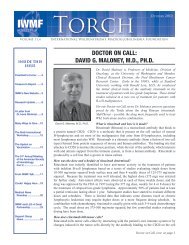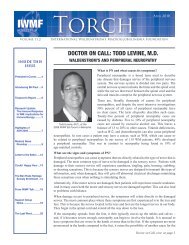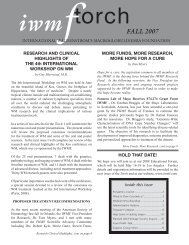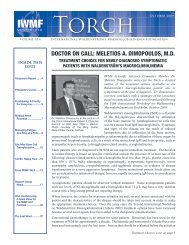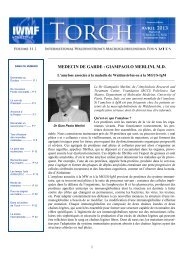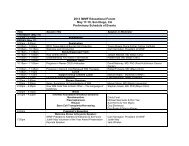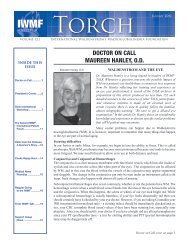English - International Waldenstrom's Macroglobulinemia Foundation
English - International Waldenstrom's Macroglobulinemia Foundation
English - International Waldenstrom's Macroglobulinemia Foundation
Create successful ePaper yourself
Turn your PDF publications into a flip-book with our unique Google optimized e-Paper software.
ASH 2012 HIGHLIGHTS<br />
B y Sue Herms, IWMF Trustee<br />
The 54th Annual Meeting of the American Society of<br />
Hematology (ASH) was held on December 8-11, 2012,<br />
in Atlanta, GA. The IWMF staffs a booth each year at<br />
this conference, which attracts hundreds of clinicians and<br />
researchers, as well as exhibitors from pharmaceutical<br />
companies, medical technology industries, and patient<br />
advocacy groups. The IWMF was represented by Dr.<br />
Robert Kyle, Trustee and Chair of the Scientific Advisory<br />
Committee (SAC); President Carl Harrington; Vice President<br />
for Research Tom Myers; and Business Office Manager Sara<br />
McKinnie.<br />
A number of poster and oral presentations at ASH focused on<br />
WM, and they are organized here into broad topics. Some<br />
interesting trends were noted in this year’s ASH abstracts.<br />
One was the number of studies assessing the prevalence<br />
of and attempting to characterize the importance of the<br />
MYD88 L265P mutation in WM cells. Another trend was<br />
the number of abstracts discussing how and why IgM-MGUS<br />
can progress to WM, and a third involved several analyses<br />
of how the WM clone changes over the course of disease<br />
progression.<br />
BIOLOGY OF WM<br />
Dr. Guang Yang, et al. from Dana-Farber Cancer Institute<br />
sought to identify the pathway(s) by which the MYD88<br />
L265P mutation promotes the growth and survival of WM<br />
cells. This mutation was identified as being widely expressed<br />
(>90%) in WM patients in recent studies reported by Dr.<br />
Steven Treon at the same institution. WM cells were isolated<br />
from bone marrow biopsy specimens of WM patients in a<br />
series of experiments that identified activation of Bruton’s<br />
tyrosine kinase (BTK) by the mutation as an important factor<br />
that promotes the survival of WM cells. BTK is an enzyme<br />
that plays a crucial role in B-cell development and mast cell<br />
activation. The use of a BTK inhibitor (PCI-32765) blocked<br />
NF-kappa B and STAT3 signaling, induced WM tumor cell<br />
killing, and was enhanced by the presence of an IRAK1/4<br />
kinase inhibitor.<br />
Dr. Anne J. Novak, et al. from the Mayo Clinic sought to<br />
confirm the incidence of the MYD88 L265P mutation in this<br />
institution’s WM/LPL and other indolent lymphoma patients<br />
and to identify the cell pathways that it impacts. MYD88<br />
plays a key role in the immune response and activates a cell<br />
signaling cascade that results in activation of NF-kappa B and<br />
STAT3 signaling. This study found that 70% of WM tumors<br />
had the mutation and that a validation set of WM patients had a<br />
similar mutation rate of 68%. Additionally both the MWCL1<br />
and the BCWM.1 cell lines, which are used in pre-clinical<br />
studies of WM, display the mutation. Using these cell lines,<br />
the researchers wanted to confirm that the L265P mutation<br />
can activate the MYD88 pathway, and their data suggest<br />
that such is indeed the case, resulting in activation of NFkappa<br />
B. Next, they wanted to confirm the significance of the<br />
MYD88 pathway on lymphoma cell growth. Again using the<br />
cell lines, they tested the effect of IRAK1/4, TAK1, and NFkappa<br />
B inhibitors on cell growth and found that the cell lines<br />
were sensitive to the TAK1 and NF-kappa B inhibitors in a<br />
dose dependent manner; however, sensitivity to the IRAK1/4<br />
inhibitor was detected only at the highest dose in one cell<br />
line. Additionally, the same inhibitors reduced the level of<br />
Interleukin 10 (IL-10) secreted by each of the cell lines. IL-<br />
10 is a cytokine (cell signaling protein) that enhances B-cell<br />
survival, proliferation, and antibody production.<br />
Angiogenesis (new blood vessel formation) is elevated in<br />
many blood cancers, but there is limited information about<br />
angiogenesis in WM. To address this issue, an abstract<br />
presented by Efstathios Kastritis, et al. from the University<br />
of Athens in Greece reported on the serum levels in WM<br />
patients of several cytokines (cell signaling proteins) that<br />
influence angiogenesis, including VEGF, VEGF-A, bFGF,<br />
angiogenin, Ang-1, and Ang-2. Serum was drawn from 55<br />
untreated patients with symptomatic WM, 12 patients with<br />
IgM-MGUS, and 30 healthy controls. All serum levels of<br />
these cytokines except Ang-1 were markedly increased<br />
in WM patients compared to controls, and these levels<br />
correlated with serum beta2-microglobulin levels and with<br />
staging according to the <strong>International</strong> Prognostic Scoring<br />
System for WM. The levels of Ang-2 increased as the disease<br />
evolved from IgM-MGUS to symptomatic WM, while the<br />
levels of Ang-1 decreased. The researchers suggest that the<br />
levels of Ang-2 may be associated with significantly shorter<br />
progression free survival.<br />
Dr. Yang Cao, et al. of Dana-Farber Cancer Institute<br />
discussed the use of whole genome sequencing (which<br />
determines the complete DNA sequence of an individual)<br />
to identify a mutation in the CXCR4 gene which is present<br />
in 29% of WM patients. The gene plays an important role<br />
in the development of lymphocytes and their movement in<br />
and out of the bone marrow. Mutations in this gene can lead<br />
to increased movement of cells, and the study suggests that<br />
CXCR4 inhibitors might be useful in the therapy of WM.<br />
Dr. Lucy S. Hodge, et al. from the Mayo Clinic examined the<br />
role of T-cells in the tumor environment and their influence<br />
in the biology of malignant cells of many blood cancers,<br />
often through cytokine (cell signaling protein) interactions.<br />
Recent studies involving healthy B-cells and CD4 T-cells<br />
identified interplay between the Interleukins IL-6 and IL-21,<br />
whereby IL-6 increased IL-21 production by T-cells, driving<br />
the differentiation and IL-6 secretion of nearby B-cells. In<br />
WM, IL-6 is elevated in the bone marrow and is associated<br />
with increased IgM production. However, the function of IL-<br />
21 in WM and its relationship to IL-6 is poorly understood.<br />
ASH Highlights, cont. on page 13<br />
12 IWMF TORCH Volume 14.2



